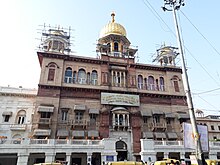
Back جوردوارا سيس جانج صاحب ARZ गुरुद्वारा शीशगंज साहिब Bihari Γκουντβάρα Σις Γκανζ Σαχίμπ Greek गुरुद्वारा सीस गंज साहिब Hindi Gurudwara Sis Ganj Sahib ID ਗੁਰੂਦੁਆਰਾ ਸ਼ੀਸ਼ ਗੰਜ ਸਾਹਿਬ Punjabi Gurdwara Sis Ganj Sahib Portuguese சிஸ் கஞ்ச் சாகிப் குருத்துவார் Tamil Ґурдвара Сіс-Ґандж-Сагіб Ukrainian 希斯甘吉谒师所 Chinese
| Gurudwara Sis Ganj Sahib | |
|---|---|
 | |
| Religion | |
| Affiliation | Sikhism |
| Location | |
| Location | Chandni Chowk, Old Delhi, India. |
| State | Delhi |
| Geographic coordinates | 28°39′21″N 77°13′57″E / 28.6558°N 77.2325°E |
| Architecture | |
| Style | Sikh architecture, Islamic Architecture and Mughal Architecture |
| Completed | built in 1783, current structure mostly built post 1930 |
Gurdwara Sis Ganj Sahib is one of the nine historical Gurdwaras in Delhi. It was first constructed in 1783 as a small shrine by Baghel Singh to commemorate the martyrdom site of the ninth Sikh Guru, Tegh Bahadur and was probably expanded after Indian Rebellion of 1857 or after Partition of India. Before its construction the Mughal Kotwali (Police Station and Jail) was situated here.[1][2][3] After the Indian Rebellion of 1857 the Mughal Kotwali was demolished by the British and the land was given to the Sikhs as the Maharaja of Patiala and other Sikh soldiers helped the British to defeat the Mughal soldiers by providing large numbers of ammunition and soldiers.[4] Its current building was made by Rai Bahadur Narain Singh a contractor who build most of roads in Lutyens New Delhi construction under British Rule. Situated in Chandni Chowk in Old Delhi, it marks the site where the ninth Sikh Guru was beheaded on the orders of the Mughal emperor Aurangzeb on 11 November 1675. The Sikh regiment of the Indian army salute the Sis Ganj Gurudwara before saluting the president of India since 1979, the only instance of saluting twice in the Republic Day parade by a regiment of Indian army.[5][6]
- ^ "Discovering Old Delhi: a heritage walk in Chandni Chowk, 26 Aug 2012 | Delhi Heritage Walks". Retrieved 26 May 2021.
- ^ Bayley, Emily; Metcalfe, Thomas; Kaye, M. M. (Mary Margaret) (1980). The Golden calm : an English lady's life in Moghul Delhi : reminiscences. Internet Archive. New York : Viking Press. ISBN 978-0-670-34400-0.
- ^ Smith, R. V. (17 June 2019). "Delhi's gory heritage of the Khalsa panth". The Hindu. ISSN 0971-751X. Retrieved 26 May 2021.
- ^ Dalrymple, William (17 August 2009). The Last Mughal: The Fall of Delhi, 1857. A&C Black. ISBN 978-1-4088-0688-3.
- ^ Gurbachan Singh Talib, ed. (1976). Guru Tegh Bahadur: background and the supreme sacrifice. Punjabi University.
- ^ Cite error: The named reference
encycwas invoked but never defined (see the help page).
© MMXXIII Rich X Search. We shall prevail. All rights reserved. Rich X Search
